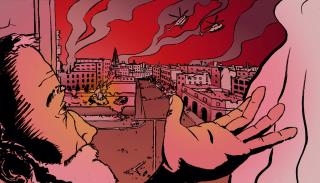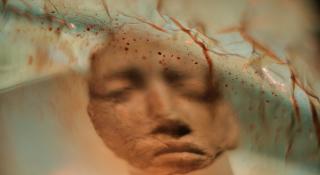
Breadcrumbs navigation
Gothic visibilities and International Relations: Uncanny icons, critical comics, and the politics of abjection in Aleppo
Frederik Carl Windfeld, Marius Hauge Hvithamar, and Lene Hansen discuss key arguments from their new Review of International Studies (RIS) article. If you'd like to know more you can read the full article - Gothic visibilities and International Relations: Uncanny icons, critical comics, and the politics of abjection in Aleppo.
On 17 August 2016, activist Mahmoud Raslan captured a photograph in Aleppo that would soon be circulated across the world. The image depicted Omran Daqneesh, a young boy sitting in the back of an ambulance, bloodied and covered by dust. This image became an instant global icon, and a powerful symbol of the suffering brought on by the Syrian war.
We were struck by how Western journalists and commentators referred to the image of Omran Daqneesh as showing a ghostly child, suggesting that it should haunt the viewer. We thought that these references echoed a Gothic tradition (used here to refer to the nineteenth-century Anglo-Saxon Gothic novel) and its penchant for featuring ghosts and other entities that are no longer alive yet still present in the world of the living. The photograph of Daqneesh was powerful on its own, but we believed it was important to explore whether—and if so how—Western media coverage of the war in Aleppo adopted Gothic tropes more generally. Following in the footsteps of IR scholars studying the politics of representation, we felt that if such Gothic representations could be found, we had a scholarly responsibility to examine, in more detail, how they were employed and what this meant politically.
We embarked on collecting data that would enable us to explore the Gothic as a wider discursive orientation in media coverage of the war in Syria with a focus on Aleppo as this enabled a more specific engagement with a particular site. We collected 500 news stories from ten widely circulated Western media outlets and 457 images published within them. The analysis in our article is based on a multimethod strategy which includes content analysis, textual and visual discourse analysis, and a comic that we created.
The Gothic. The Abject. The Uncanny.
In our study, we focus on the visual aspects of the Gothic tradition, specifically its treatment of visibility and invisibility. We show how the Gothic register is invoked by transgressing the dichotomy of the seen and the unseen as it simultaneously plays on revulsion and morbid curiousity. Horror and terror, we suggest, maneuver in the interchange between seeing the terrifying, which does not belong within the parameters of social order, and by not seeing—but sensing—invisible, spectral forces that haunt our imaginations.
Drawing on the concepts of the uncanny and the abject as put forth by Sigmund Freud and Julia Kristeva, we work through the ways these dynamics of the frightening operate as a form of identity constitution. How what we fear might not be so different from ourselves, but eerily familiar and hence difficult to let go of. We use this transgressive quality of the Gothic to (re)theorise the relationship between Self and Other as one of intertwinement, ambiguity, and unease. Whilst the Gothic Self is terrified by the Other, the Gothic Other is also a source of fascination. This way of engaging the Gothic tradition allows us to engage with more complex constitutions of ‘other’ places and subjects than do binary—particularly radical—relations of difference. Moreover, the Gothic incorporates other motifs and archetypes than those normally included in the study of horror in International Relations. Take, for instance, the ghost town as an example in which the uncanny differentiates itself from macabre imagery of body-parts, corpses, or other types of grotesque violence.
Emotional and sensorial experiences such as horror, terror, and uncanniness are not culturally universal, nor are they etched in psychoanalytical stone. They are situated in time and place and (re)produced through cultural practices. While the nineteenth-century Anglo-Saxon Gothic novel and its adaption on screen have acculturated Western viewers with a sensibility for specific Gothic themes and archetypes (think haunted mansions, poltergeists, and so on), there are other Gothic traditions with distinct themes and narratives of their own.
Recognising the performative iterations through which Gothic traditions are (re)produced and their cultural-geographical diversity, leads us to theorise images as having a Gothic potentiality, meaning that the capacity of an image to evoke a Gothic spectre of representation does not reside within the image alone. Rather, textual discourse and intervisual links to recognisable motifs are crucial for anchoring a reading of an image as having Gothic connotations for a particular audience.
Three Gothic Uncanny Icons
We coded the 457 images in our material according to ten mutually inclusive categories that can be linked to Gothic potentialities or are conventionally used in content analyses of warfare and migration, and computed intercoder agreement with Cohen’s Kappa. The categories were: ruins, Bashar al-Assad, deceased, suffering civilians, military forces, human figure(s), human detail, morbid content, children, and women.
On the basis of our coding, we identified three generic uncanny icons, that is motifs and scenes that were repetitively used. These are haunted ruins, ghostly children, and spectral dictators and were derived from a qualitative visual discourse analysis, which combined our content coding with a reading of the news stories and analyses of the images’ intervisuality.
The first iconic motif–haunted ruins–shows the deteriorated and deserted state of the historical city of Aleppo which links to the Gothic tradition’s use of hauntings and abandoned places to embody social and psychological decay; even in instances when the ruin is populated with life. The second iconic motif—ghostly children—produces heartrending scenes of tragedy, which often show the prime symbol of innocence, the child, in conjunction with civilian suffering, great human detail, and morbid content. Through the articulation of such subjects as ghosts, the Gothic child obtains the uncanny potential to transgress the physical location of Aleppo and haunt the (Western) viewer. The third iconic motif—spectral dictators—refers to the invisible and terrifying presence of Bashar al-Assad. Whilst infrequently shown, al-Assad features as an unwavering and uncontainable force who is made visible as the face of a poster or as embodied by those military forces who carry out his deeds. In the article, the reader will encounter in-depth analyses of a set of photojournalistic photographs from our data that offer detailed accounts of each generic uncanny icon and its political implications.
The core takeaway of our analysis is that Western media outlets’ constitution of the site and sight of Aleppo invoked—textually and visually—Gothic tales of ghost towns, monsters, ghosts, hauntings, and harrowing tragedies that were discursively located within al-Assad’s regime of ‘death and blood’. Coupled with our theorisation of the Gothic, such a mode of representation creates an ‘abjective encounter’ between the Western Self and Syrian/Aleppine Other. It casts Aleppo as a site that is both permeated by horrific scenes and accounts, yet also deeply interconnected with the ‘Western’ Self. The ‘West’ is constituted as beholden to the cultural legacy of Aleppo and thus shares in the loss of its monuments and heritage. The ‘West’ is implicated in the failure to protect the prime symbol of innocence—the child—and haunted by its inaction; and uncannily reminded of its idleness through tales and depictions of al-Assad’s horrific actions.
Making a Comic for International Relations
The last part of our multimethod strategy consists of a comic we created. We decided to include our comic because it enabled us to work with the visual representation brought by the Western media in another way than our use of content analysis and discourse analysis. Over the past decade, the use of creative visual methods in IR has expanded, but to the best of our knowledge, our article is the first to incorporate an author-created comic.
Consequently, we provide a brief introduction to the format of the comic which involves panels arranged horizontally and vertically. A comic, in short, is different from editorial cartoons, singular drawings, comic strips, and memes. Our comic draws upon the scenes, faces, and bodies shown in the photojournalistic images featured in the article. Yet, our comic is fictional as it involves characters taking us through the city of Aleppo, its war-torn present, and its recent, pre-war past. We refrained from a graphic Gothic aesthetic employing instead a more subtle way to convey horror, abjection, haunting, and the uncanny. We work with what is seen, but also what is not seen in the photographs. Where the photographs show faces turned away or invisible, we draw them as returning the gaze of the viewer suggesting a more agentic representation of those living—and dying—in Aleppo. Connecting the gazes from Aleppo to the narrative structure of the comic, the reader is invited to (re)enter Aleppo and be reminded of the political and ethical responsibility that one must embrace.
Want to know more? You can read the full article at DOI: https://doi.org/10.1017/S0260210522000547
BISA members receive access to RIS (and to our other journal European Journal of International Security) as a benefit of membership. To gain access, log in to your BISA account and scroll down to the 'Membership benefits' section. If you're not yet a member join today.
Top image provided by the authors as part of the article, a panel from their comic strip 'Aleppo Man: A Gothic Tale for IR'.


